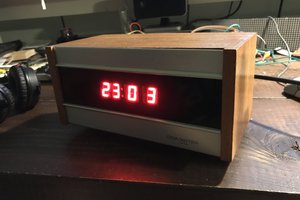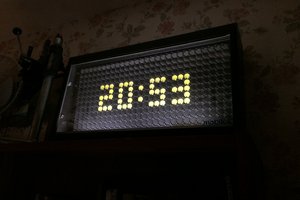This is not a new project as such, but rather a mashup of a couple of previous projects: #8042 clock and #An uninnovative linear LED display
I'm bad at finishing up projects (I lose interest when I see that they work) but I hate how they take up space on my bench, in my cupboard, or in my mind. So I decided to package this mashup even if the result is aesthetically ugly. In this case I noted that I had a wood block of the right size and lots of screws extracted from dismantled equipment over the years. So I mounted the constituent boards on the block, attached a hanger cord to it and deemed it finished. So now it can take up space on the wall instead.
I've also discovered the joys of a hot glue gun. Great for fastening things: wires, screws, small pets... 🤣
I did have to add code and fix bugs in the firmware. The code is on Github for the #8042 clock project. In particular I have to drive a 74HC595 shift register display. This is trivial even for a benighted MCU like the 8042. Pin P2.4 is used to drive the seconds blink. You will also see code there to get timing from the mains, using pin P2.3. Thus the power supply has to be the old-school iron transformer type so that we can derive a 50 Hz square wave for the clock. I have a few of those salvaged from e-waste bins but they are a disappearing breed, as SMPS are used now. The rectifier circuit is conventional and the mains squarer circuit is similar to those in #Restoring a Beckman neon display clock or #DTL binary clock For a mains transformer we get long term accuracy, as power grid operators are required to supply the right number of cycles over time.
 Ken Yap
Ken Yap

 Henry York
Henry York
 Supercrab
Supercrab
 pauliusbau
pauliusbau